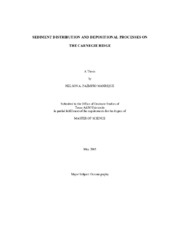| dc.description.abstract | Sediment sampling, bathymetric data, and seismic reflection profiling were used to classify sediment deposition patterns on the Carnegie Ridge. Core sampling was used to relate compositional characteristics between equivalent areas, and seismic profiling to establish vertical variations. Three study areas were selected based on core distribution along the ridge. Grids of the following parameters were obtained: slope, elevation, percentage of carbonate, SiO2, and organic carbon contents. The general CaCO3 content distribution is highest on the ridge except in the areas affected by terrigenous deposition from the mainland, and volcanic debris from Galapagos Volcanic Platform. The general SiO2 content distribution is highest south of the Equator, bordering the west ridge. The organic carbon content is high in the equatorial upwelling area and close to the mainland. The relationship between organic carbon and carbonate was determined through correlation analysis. Based on those analyses, and considering the mixture of sedimentary sources and tectonic processes, the carbonate sediment is more important to this area. Sediments on the Carnegie Ridge above the lysocline are affected by three different types of processes controlling the sediment deposition. The first is the location of the high productivity zone in which pelagic settling is the source of sediment. The second is the difference in sea water properties between the Panama and Peru Basins surrounding the ridge, which creates different depositional environments. These properties create horizontal and vertical variations within water masses. Intermediate depths are affected by northward Pacific Central Water and bottom waters by northward Pacific Deep Water. The deflection of the bottom water flow by the existence of the Carnegie Ridge as a natural barrier produces scouring effects on the south flank. The third process controlling deposition is underwater dissolution on the saddle and east ridge by organic carbon degradation, which is enhanced by bottom water flow. Significant differences in sedimentation types were found in areas with hilltops, contrasted slopes, and slope bases, primarily related to changing depths and water flows, and lateral transport along the steepest north scarp. | en |


